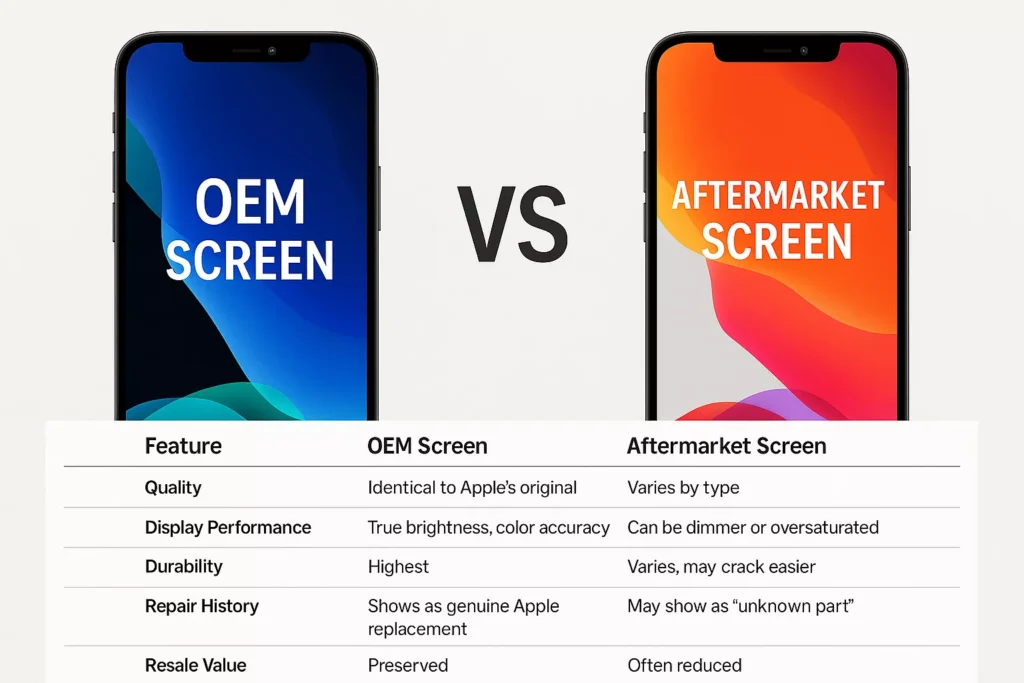OEM vs Aftermarket iPhone Screens: What’s the Difference?
If you’ve cracked your iPhone screen, you’ll quickly notice repair shops and online sellers offering two options: OEM screens and aftermarket screens. The difference between original and aftermarket iPhone screens is one of the most common sources of confusion for customers. Knowing what these terms mean will help you choose the right screen for your phone and your budget.
What Does OEM Mean?
If you’ve cracked your iPhone screen, you’ll quickly notice iPhone repair shops and online sellers offering two options: OEM screens and aftermarket screens. The difference between original and aftermarket iPhone screens is one of the most common sources of confusion for customers. Knowing what these terms mean will help you choose the right screen for your phone and your budget.
What Are Aftermarket Screens?
Aftermarket screens are produced by third-party manufacturers, not Apple. Quality can range from decent to poor, depending on the type of aftermarket screen. The most common types are:
- Incell – A budget-friendly option. Decent performance but slightly dimmer and less vibrant.
- OLED (aftermarket) – Closer to original quality. Colors are more vivid, but durability may be lower.
- GX/Other Premium Aftermarket – Marketed as “high copy” screens. Can look very close to OEM, but still not identical.
One important note: If you replace your iPhone screen with an aftermarket version, your iPhone repair history may show it as “unknown part.” This can hurt trade-in or buyback value, since some stores will treat it as if the screen is still broken. OEM replacements, however, show as original parts.
OEM vs Aftermarket iPhone Screens: Pros & Cons
| Feature | OEM Screen | Aftermarket Screen |
|---|---|---|
| Quality | Identical to Apple's original | Varies by type (Incell, OLED, GX) |
| Display Performance | True brightness, color accuracy | Can be dimmer or oversaturated |
| Durability | Highest | Varies, may crack easier |
| Repair History | Shows as genuine Apple replacement | May show as “unknown part” |
| Resale Value | Preserved | Often reduced |
| Cost | Higher | More affordable |
Cost Difference
- OEM screen replacement: More expensive, but you’re paying for top quality and better long-term value.
- Aftermarket screen replacement: Usually 30-50% cheaper, making it a budget-friendly option for older devices or temporary fixes.
When Should You Choose OEM vs Aftermarket?
- Choose OEM if you plan to keep your iPhone long-term, care about screen performance, or want the best resale/trade-in value.
- Choose Aftermarket if you’re on a budget, have an older phone, or just need a quick fix without investing too much.
The choice between OEM vs aftermarket iPhone screens comes down to how much you value performance, warranty, and resale value compared to saving money upfront. Both options can work, but knowing the difference helps you make an informed decision.
Not sure which one you currently have?
Fake vs Real iPhone Screen: How to Know if Yours is Original
At iMobile Repair Center in Detroit, we stock high-quality Incell aftermarket screens as our main option, with limited OEM screens available when in stock. This way, you can choose the repair that fits your budget and your iPhone’s needs.
Check our iPhone repair services here.
